Load Frequency Control (LFC) Strategies in Renewable Energy-Based Hybrid Power Systems: A Review
Abstract
:1. Introduction
1.1. Literature Review
1.2. Research Motivation
1.3. Contribution and Novelty
- (a)
- A comprehensive review of load frequency control for hybrid power systems.
- (b)
- Review of different types of renewable energy systems tied with conventional power systems and the resulting load frequency control.
- (c)
- Challenges and opportunities in load frequency control of hybrid power systems.
- (d)
- Graphical analysis of undershoot, overshoot and settling time parameters performed for major load frequency schemes.
- (e)
- Analysis of existing LFC techniques and its shortcomings. Suggestion about the future work for better LFC control.
2. Review on Load Frequency Control Considering Renewable Energy Sources
2.1. Single-Area Power System
2.2. Multi-Area Power System
2.3. Multi-Stage Controllers
3. Types of Controllers on the Basis of Different Control Techniques
3.1. PID-Based Controllers
3.2. Fuzzy Logic-Based Controllers
3.3. Artificial Neural Network (ANN) and Sliding Mode Controllers (SMC)
3.4. Tilt Integral Derivative Controller
4. Future Scope of Work
- Researching the AI techniques for the training of LFC optimization algorithms to employ the intelligent control of a power system in large networks.
- Accommodating the impact of transmission line congestion into an optimization algorithm of LFC.
- Developing some more robust and adaptive control topologies for LFC development.
- Improving the model predictive function to predict and forecast the environmental variation impacts in LFC design for renewable energy systems.
- Working on the cybersecurity systems to avoid attacks on LFC operation in smart grid structures.
- Development of optimal robust control techniques for LFC in such a way that it can tackle the power production and parameter variations of the system.
- Work to improve the reliability of LFC loops.
- Development of control methods for self-isolation of LFC under fault conditions
- Developing a better interaction between LFC and AVR control loops
5. Conclusions
Author Contributions
Funding
Institutional Review Board Statement
Informed Consent Statement
Data Availability Statement
Conflicts of Interest
References
- Çam, E.; Kocaarslan, I. Load frequency control in two area power systems using fuzzy logic controller. Energy Convers. Manag. 2005, 46, 233–243. [Google Scholar] [CrossRef]
- Khodabakhshian, A.; Hooshmand, R. A new PID controller design for automatic generation control of hydro power systems. Int. J. Electr. Power Energy Syst. 2010, 32, 375–382. [Google Scholar] [CrossRef]
- Daud, S.; Ali, M.; Naveed, A.; Hadeed, A.S.; Muhammad, G. Multi Control Adaptive Fractional Order PID Control Approach for PV/Wind Connected Grid System. Int. Trans. Electr. Energy Syst. 2021, 31, e12809. [Google Scholar]
- Hsu, Y.Y.; Chan, W.C. Optimal variable structure controller for the load-frequency control of interconnected hydrothermal power systems. Int. J. Electr. Power Energy Syst. 1984, 6, 221–229. [Google Scholar] [CrossRef]
- Verma, Y.P.; Kumar, A. Load frequency control in deregulated power system with wind integrated system using fuzzy controller. Front. Energy 2013, 7, 245–254. [Google Scholar] [CrossRef]
- Hasanien, H.M. Whale optimisation algorithm for automatic generation control of interconnected modern power systems including renewable energy sources. IET Gener. Transm. Distrib. 2018, 12, 607–614. [Google Scholar] [CrossRef]
- Yousef, H.A.; Al-Kharusi, K.; Albadi, M.H.; Hosseinzadeh, N. Load frequency control of a multi-area power system: An adaptive fuzzy logic approach. IEEE Trans. Power Syst. 2014, 29, 1822–1830. [Google Scholar] [CrossRef]
- Shiva, C.K.; Mukherjee, V. A novel quasi-oppositional harmony search algorithm for automatic generation control of power system. Appl. Soft Comput. J. 2015, 35, 749–765. [Google Scholar] [CrossRef]
- Snehal, G.; Krishan, A. Automatic generation control of multi area power plants with the help of advanced controller. Int. J. Eng. Res. 2015, V4, 470–474. [Google Scholar]
- Shiroei, M.; Toulabi, M.R.; Ranjbar, A.M. Robust multivariable predictive based load frequency control considering generation rate constraint. Int. J. Electr. Power Energy Syst. 2013, 46, 405–413. [Google Scholar] [CrossRef]
- Haes Alhelou, H.; Hamedani Golshan, M.E.; Hajiakbari Fini, M. Wind Driven Optimization Algorithm Application to Load Frequency Control in Interconnected Power Systems Considering GRC and GDB Non Linearitirs. Electr. Power Compon. Syst. 2018, 46, 1223–1238. [Google Scholar] [CrossRef]
- Jagatheesan, K.; Anand, B.; Samanta, S.; Dey, N.; Santhi, V.; Ashour, A.S.; Balas, V.E. Application of flower pollination algorithm in load frequency control of multi-area interconnected power system with nonlinearity. Neural Comput. Appl. 2017, 28, 475–488. [Google Scholar] [CrossRef]
- Khooban, M.H.; Niknam, T. A new intelligent online fuzzy tuning approach for multiarea load frequency control: Self adaptive modified bat algorithm. Int. J. Electr. Power Energy Syst. 2015, 71, 254–261. [Google Scholar] [CrossRef]
- Padhan, D.G.; Majhi, S. A new control scheme for PID load frequency controller of single-area and multi-area power systems. ISA Trans. 2013, 52, 242–251. [Google Scholar] [CrossRef] [PubMed]
- Rehman, U.U.; Jameel, A.; Khan, A.; Gulzar, M.M.; Murawwat, S. Load Frequency Management for a two-area system (Thermal-PV & Hydel-PV) by Swarm Optimization based Intelligent Algorithms. In Proceedings of the 2021 International Conference on Emerging Power Technologies (ICEPT), Topi, Pakistan, 10–11 April 2021; pp. 1–6. [Google Scholar] [CrossRef]
- Bhongade, S.; Gupta, H.O.; Tyagi, B. Artificial neural network based automatic generation control scheme for deregulated electricity market. In Proceedings of the 2010 Conference Proceedings IPEC, Singapore, 27–29 October 2010; pp. 1158–1163. [Google Scholar]
- Ameli, A.; Hooshyar, A.; Yazdavar, A.H.; El-Saadany, E.F.; Youssef, A. Attack detection for load frequency control systems using stochastic unknown input estimators. IEEE Trans. Inf. Forensics Secur. 2018, 13, 2575–2590. [Google Scholar] [CrossRef]
- Chandra Sekhar, G.T.; Sahu, R.K.; Baliarsingh, A.K.; Panda, S. Load frequency control of power system under deregulated environment using optimal firefly algorithm. Int. J. Electr. Power Energy Syst. 2016, 74, 195–211. [Google Scholar] [CrossRef]
- Pappachen, A.; Peer Fathima, A. Load frequency control in deregulated power system integrated with SMES-TCPS combination using ANFIS controller. Int. J. Electr. Power Energy Syst. 2016, 82, 519–534. [Google Scholar] [CrossRef]
- Arya, Y.; Kumar, N. AGC of a multi-area multi-source hydrothermal power system interconnected via AC/DC parallel links under deregulated environment. Int. J. Electr. Power Energy Syst. 2016, 75, 127–138. [Google Scholar] [CrossRef]
- Mohanty, B.; Hota, P.K. Comparative performance analysis of fruit fly optimization algorithm for multi-area multisource automatic generation control under deregulated environment. IET Gener. Transm. Distrib. 2015, 9, 1845–1855. [Google Scholar] [CrossRef]
- Falahati, S.; Taher, S.A.; Shahidehpour, M. Grid frequency control with electric vehicles by using of an optimized fuzzy controller. Appl. Energy 2016, 178, 918–928. [Google Scholar] [CrossRef]
- Mahmood, H.; Michaelson, D.; Jiang, J. Decentralized power management of a PV/ battery hybrid unit in a droop-controlled islanded microgrid. IEEE Trans. Power Electron. 2015, 30, 7215–7229. [Google Scholar] [CrossRef]
- Shankar, G.; Mukherjee, V. Load frequency control of an autonomous hybrid power system by quasi-oppositional harmony search algorithm. Int. J. Electr. Power Energy Syst. 2016, 78, 715–734. [Google Scholar] [CrossRef]
- Yousri, D.; Sudhakar, T.; Fathy, A. Recent methodology based Harris Hawks optimizer for designing load frequency control incorporated in multi-interconnected renewable energy plants. Sustain. Energy Grids Netw. 2020, 22, 100352. [Google Scholar] [CrossRef]
- Sahu, R.K.; Gorripotu, T.S.; Panda, S. A hybrid DE–PS algorithm for load frequency control under deregulated power system with UPFC and RFB. Ain Shams Eng. J. 2015, 6, 893–911. [Google Scholar] [CrossRef] [Green Version]
- Kler, D.; Kumar, V.; Rana, K.P.S. Optimal integral minus proportional derivative controller design by evolutionary algorithm for thermal-renewable energy-hybrid power systems. IET Renew. Power Gener. 2019, 13, 2000–2012. [Google Scholar] [CrossRef]
- Qadikolai, M.H. Frequency control of isolated hybride power netwotk using genethic algorithm and particle swarm optimization. In Proceedings of the 2015 30th International Power System Conference (PSC), Tehran, Iran, 23–25 November 2015; Volume 3, pp. 184–189. [Google Scholar]
- Latif, A.; Das, D.C. Performance analysis of CSA optimized PIDF controller for containing frequency fluctuation of micro-grid. In Proceedings of the 2018 3rd International Conference for Convergence in Technology (I2CT), Pune, India, 6–8 April 2018; pp. 1–6. [Google Scholar]
- Sharma, D.; Yadav, N.K. Lion Algorithm with Levy Update: Load frequency controlling scheme for two-area interconnected multi-source power system. Trans. Inst. Meas. Control 2019, 41, 4084–4099. [Google Scholar] [CrossRef]
- Jain, S.; Hote, Y.V. Design of fractional PID for Load frequency control via Internal model control and Big bang Big crunch optimization. IFAC-Pap. OnLine 2018, 51, 610–615. [Google Scholar] [CrossRef]
- Debbarma, S.; Saikia, L.C.; Sinha, N. Automatic generation control using two degree of freedom fractional order PID controller. Int. J. Electr. Power Energy Syst. 2014, 58, 120–129. [Google Scholar] [CrossRef]
- Chathoth, I.; Ramdas, S.K.; Krishnan, S.T. Fractional-order proportional-integral-derivative- based automatic generation control in deregulated power systems. Electr. Power Compon. Syst. 2015, 43, 1931–1945. [Google Scholar] [CrossRef]
- Sondhi, S.; Hote, Y.V. Fractional order PID controller for perturbed load frequency control using Kharitonov’s theorem. Int. J. Electr. Power Energy Syst. 2016, 78, 884–896. [Google Scholar] [CrossRef]
- Saxena, S. Load frequency control strategy via fractional-order controller and reduced- order modeling. Int. J. Electr. Power Energy Syst. 2019, 104, 603–614. [Google Scholar] [CrossRef]
- Nithilasaravanan, K.; Thakwani, N.; Mishra, P.; Kumar, V.; Rana, K.P.S. Efficient control of integrated power system using self-tuned fractional-order fuzzy PID controller. Neural Comput. Appl. 2019, 31, 4137–4155. [Google Scholar] [CrossRef]
- Wang, H.; Zeng, G.; Dai, Y.; Bi, D.; Sun, J.; Xie, X. Design of a fractional order frequency PID controller for an islanded microgrid: A multi-objective extremal optimization method. Energies 2017, 10, 1502. [Google Scholar] [CrossRef] [Green Version]
- Dash, P.; Saikia, L.C.; Sinha, N. Flower pollination algorithm optimized PI-PD cascade controller in automatic generation control of a multi-area power system. Int. J. Electr. Power Energy Syst. 2016, 82, 19–28. [Google Scholar] [CrossRef]
- Pandey, S.K.; Kishor, N.; Mohanty, S.R. Frequency regulation in hybrid power system using iterative proportional-integral-derivative H ∞ controller. Electr. Power Compon. Syst. 2014, 42, 132–148. [Google Scholar] [CrossRef]
- Rahman, A.; Saikia, L.C.; Sinha, N. Load frequency control of a hydro-thermal system under deregulated environment using biogeography-based optimised three-degree- of-freedom integral-derivative controller. IET Gener. Transm. Distrib. 2015, 9, 2284–2293. [Google Scholar] [CrossRef]
- Golpîra, H.; Bevrani, H. A framework for economic load frequency control design using modified multi-objective genetic algorithm. Electr. Power Compon. Syst. 2014, 42, 788–797. [Google Scholar] [CrossRef]
- Sahu, B.K.; Pati, S.; Panda, S. Hybrid differential evolution particle swarm optimization optimised fuzzy proportional-integral derivative controller for automatic generation control of interconnected power system. IET Gener. Transm. Distrib. 2014, 8, 1789–1800. [Google Scholar] [CrossRef]
- Bahgaat, N.K.; El-Sayed, M.I.; Hassan, M.A.M.; Bendary, F.A. Load frequency control in power system via improving PID controller based on particle swarm optimization and ANFIS techniques. Int. J. Syst. Dyn. Appl. 2014, 3, 1–24. [Google Scholar] [CrossRef]
- Malik, H.; Mahto, V.M.T. Fractional Order Control and Simulation of Wind-Biomass Isolated Hybrid Power System Using Particle Swarm Optimization; Springer: Singapore, 2019; Volume 698. [Google Scholar]
- Abdelaziz, A.Y.; Ali, E.S. Cuckoo Search algorithm based load frequency controller design for nonlinear interconnected power system. Int. J. Electr. Power Energy Syst. 2015, 73, 632–643. [Google Scholar] [CrossRef]
- Chaine, S.; Tripathy, M.; Jain, D. Non dominated Cuckoo search algorithm optimized controllers to improve the frequency regulation characteristics of wind thermal power system. Eng. Sci. Technol. Int. J. 2017, 20, 1092–1105. [Google Scholar] [CrossRef]
- Gheisarnejad, M. An effective hybrid harmony search and cuckoo optimization algorithm based fuzzy PID controller for load frequency control. Appl. Soft Comput. 2018, 65, 121–138. [Google Scholar] [CrossRef]
- Ali, E.S.; Abd-Elazim, S.M. BFOA based design of PID controller for two area Load Frequency Control with nonlinearities. Int. J. Electr. Power Energy Syst. 2013, 51, 224–231. [Google Scholar] [CrossRef]
- Dhillon, S.S.; Lather, J.S.; Marwaha, S. Multi objective load frequency control using hybrid bacterial foraging and particle swarm optimized PI controller. Int. J. Electr. Power Energy Syst. 2016, 79, 196–209. [Google Scholar] [CrossRef]
- Qian, D.; Tong, S.; Liu, H.; Liu, X. Load frequency control by neural-network-based integral sliding mode for nonlinear power systems with wind turbines. Neurocomputing 2016, 173, 875–885. [Google Scholar] [CrossRef]
- Prakash, S.; Sinha, S.K. Simulation based neuro-fuzzy hybrid intelligent PI control approach in four-area load frequency control of interconnected power system. Appl. Soft Comput. 2014, 23, 152–164. [Google Scholar] [CrossRef]
- Zhang, F.; Li, Q. Deep learning-based data forgery detection in automatic generation control. In Proceedings of the 2017 IEEE Conference on Communications and Network Security (CNS), Las Vegas, NV, USA, 9–11 October 2017; pp. 400–404. [Google Scholar]
- Ulbig, A.; Rinke, T.; Chatzivasileiadis, S.; Andersson, G. Predictive control for real-time frequency regulation and rotational inertia provision in power systems. In Proceedings of the 52nd IEEE Conference on Decision and Control, Florence, Italy, 10–13 December 2013; pp. 2946–2953. [Google Scholar]
- Shiroei, M.; Ranjbar, A.M. Supervisory predictive control of power system load frequency control. Int. J. Electr. Power Energy Syst. 2014, 61, 70–80. [Google Scholar] [CrossRef]
- Anwar, M.N.; Pan, S. A new PID load frequency controller design method in frequency domain through direct synthesis approach. Int. J. Electr. Power Energy Syst. 2015, 67, 560–569. [Google Scholar] [CrossRef]
- Liu, X.; Kong, X.; Lee, K.Y. Distributed model predictive control for load frequency control with dynamic fuzzy valve position modelling for hydro–thermal power system. IET Control Theory Appl. 2016, 10, 1653–1664. [Google Scholar] [CrossRef]
- Hanan, M.; Javed, M.Y.; Ai, X.; Gulzar, M.M.; Ahmad, S. A Two-Stage Algorithm to Harvesting Maximum Power from Photovoltaic System. In Proceedings of the IEEE International Conference on Energy Internet and Energy System Integration (EI2), Beijing, China, October 2018; pp. 1–6. [Google Scholar]
- Javed, M.Y.; Murtaza, A.F.; Ling, Q.; Qamar, S.; Gulzar, M.M. A Novel MPPT design using Generalized Pattern Search for Partial Shading. Energy Build. 2016, 133, 59–69. [Google Scholar] [CrossRef]
- Qi, X.; Bai, Y. Improved linear active disturbance rejection control for microgrid frequency regulation. Energies 2017, 10, 1047. [Google Scholar] [CrossRef] [Green Version]
- Xie, M.; Gulzar, M.M.; Tehreem, H.; Javed, M.Y.; Rizvi, S.T.H. Automatic Voltage Regulation of Grid Connected Photovoltaic System Using Lyapunov Based Sliding Mode Controller: A Finite-Time Approach. Int. J.Control. Autom. Systems. 2020, 18, 1550–1560. [Google Scholar] [CrossRef]
- Hirsch, A.; Parag, Y.; Guerrero, J. Microgrids: A review of technologies, key drivers, and outstanding issues. Renew. Sustain. Energy Rev. 2018, 90, 402–411. [Google Scholar] [CrossRef]
- Khan, F.U.; Gulzar, M.M.; Sibtain, D.; Usman, H.M.; Hayat, A. Variable step size fractional incremental conductance for MPPT under changing atmospheric conditions. Int. J. Numer.Model. Electron.Netw. Devices Fields. 2020, 33, 1–18. [Google Scholar]
- Gulzar, M.M.; Sharif, B.; Iqbal, S.; Javed, M.Y.; Sibtain, D. Management of Energy and Comfort Facilities in Modern Buildings using Fuzzy Logic. New Horiz. J. Inst. Electr. Electron. Eng. Pakistan 2017, 91–96, 30–34. [Google Scholar]
- Gulzar, M.; Rizvi, S.; Javed, M.; Sibtain, D.; Din, R.S.U. Mitigating the load frequency fluctuations of interconnected power systems using Model Predictive Controller. Electronics 2019, 8, 156. [Google Scholar] [CrossRef] [Green Version]
- Patel, N.C.; Debnath, M.K.; Sahu, B.K.; Dash, S.S.; Bayindir, R. Application of Invasive Weed Optimization Algorithm to optimally design Multi-staged PID controller for LFC Analysis. Int. J. Renew. Energy Res. 2019, 9, 470–479. [Google Scholar]
- Javed, H.; Muqeet, H.A.; Shehzad, M.; Jamil, M.; Khan, A.A.; Guerrero, J.M. Optimal Energy Management of a Campus Microgrid Considering Financial and Economic Analysis with Demand Response Strategies. Energies. 2021, 14, 8501. [Google Scholar] [CrossRef]
- Anbarasi, S.; Muralidharan, S. Hybrid BFPSO approach for effective tuning of PID controller for Load Frequency Control Application in an interconnected power system. J. Electr. Eng. Technol. 2017, 12, 1027–1037. [Google Scholar] [CrossRef] [Green Version]
- Guha, D.; Roy, P.K.; Banerjee, S. Symbiotic organism search algorithm applied to load frequency control of multi-area Power System. Energy Syst. 2017, 9, 439–468. [Google Scholar] [CrossRef]
- Elsaied, M.M.; Attia, M.A.; Mostafa, M.A.; Mekhamer, S.F. Application of different optimization techniques to Load frequency control with WECS in A Multi-Area System. Electr. Power Compon. Syst. 2018, 46, 739–756. [Google Scholar] [CrossRef]
- Guha, D.; Roy, P.K.; Banerjee, S. Application of backtracking search algorithm in load frequency control of multi-area interconnected power system. Ain Shams Eng. J. 2018, 9, 257–276. [Google Scholar] [CrossRef] [Green Version]
- Bhongade, S. Automatic generation control of two-area ST-Thermal power system using jaya algorithm. Int. J. Smart Grid 2018, 2, 99–110. [Google Scholar]
- Shah, J.S.; Suleyman, S.T.; İbrahim, K.; Zakirhussain, F. Gravitational Search Algorithm (GSA) based PID Controller Design for Two Area Multi-Source Power System Load Frequency Control. J. Control Sci. 2018, 31, 139–153. [Google Scholar]
- Prasun, S.; Basu, M. New approach in two-area interconnected AGC including various renewable energy sources Using PSO. Turk. J. Electr. Eng. Comput. Sci. 2018, 26, 1491–1504. [Google Scholar]
- Annamraju, A.; Nandiraju, S. Coordinated control of conventional power sources and PHEVs using jaya algorithm optimized PID controller for frequency control of a renewable penetrated power system. Prot. Control Mod. Power Syst. 2019, 4, 1–13. [Google Scholar] [CrossRef] [Green Version]
- Dey, P.P.; Das, D.C.; Latif, A.; Hussain, S.M.; Ustun, T.S. Active power management of virtual power plant UNDER penetration of CENTRAL Receiver SOLAR Thermal-Wind using Butterfly optimization technique. Sustainability 2020, 12, 6979. [Google Scholar] [CrossRef]
- Kong, F.; Li, J.; Yang, D. Multi-Area load frequency control of hydro-thermal-wind power based on improved grey Wolf optimization algorithm. Elektron. Ir Elektrotechnika 2020, 26, 32–39. [Google Scholar] [CrossRef]
- Abo-Elyousr, F.K.; Abdelaziz, A.Y. A novel modified robust load frequency control for mass-less inertia photovoltaics penetrations via hybrid PSO-Woa Approach. Electr. Power Compon. Syst. 2019, 47, 1744–1758. [Google Scholar] [CrossRef]
- Zaheeruddin; Singh, K. Primary frequency regulation of a microgrid by deloaded tidal turbines. Soft Comput. 2020, 24, 14667–14685. [Google Scholar] [CrossRef]
- Alattar, H.; Selem, S.I.; Metwally, H.M.; Ibrahim, A.; Aboelsaud, R.; Tolba, M.A.; El-Rifaie, A.M. Performance enhancement of micro grid system with smes storage system based on mine blast optimization algorithm. Energies 2019, 12, 3110. [Google Scholar] [CrossRef] [Green Version]
- Ranjan, S.; Das, D.C.; Behera, S.; Sinha, N. Parabolic trough solar–thermal–wind–diesel isolated hybrid power system: Active power/frequency control analysis. IET Renew. Power Gener. 2018, 12, 1893–1903. [Google Scholar] [CrossRef]
- Annamraju, A.; Nandiraju, S. A Novel Fuzzy Tuned Multistage PID Approach for Frequency Dynamics Control in an Islanded Microgrid; John Wiley & Sons: Hoboken, NJ, USA, 2020. [Google Scholar]
- Singh, A.; Suhag, S. Frequency regulation in AC microgrid with and without electric vehicle using multiverse-optimized fractional order- PID controller. Int. J. Comput. Digit. Syst. 2019, 8, 375–385. [Google Scholar] [CrossRef]
- Fayek, H.H.; Mohammadi-Ivatloo, B. Tidal supplementary CONTROL Schemes-Based Load frequency regulation of a fully Sustainable Marine Microgrid. Inventions 2020, 5, 53. [Google Scholar] [CrossRef]
- Kumar; Shankar, G. Quasi-oppositional harmony search algorithm based optimal dynamic load frequency control of a hybrid tidal–diesel power generation system. IET Gener. Transm. Distrib. 2018, 12, 1099–1108. [Google Scholar] [CrossRef]
- Jumani, T.; Mustafa, M.; Rasid, M.; Mirjat, N.; Baloch, M.; Salisu, S. Optimal Power Flow Controller for grid-connected microgrids using grasshopper optimization algorithm. Electronics 2019, 8, 111. [Google Scholar] [CrossRef] [Green Version]
- Hussain, I.; Ranjan, S.; Das, D.C.; Sinha, N. Performance analysis of flower pollination algorithm optimized pid controller for wind-PV-SMES-BESS-Diesel Autonomous hybrid Power System. Int. J. Renew. Energy Res. 2017, 7, 643–651. [Google Scholar]
- Arora, K.; Kumar, A.; Kamboj, V.K.; Prashar, D.; Shrestha, B.; Joshi, G.P. Impact of renewable energy sources into multi area multi-source load frequency control of interrelated power system. Mathematics 2021, 9, 186. [Google Scholar] [CrossRef]
- Boddepalli, M.K.; Pilla, R.; Gorripotu, T.S.; Kumar, D.V. Design and analysis OF bfoa OPTIMISED PID controller with Derivative filter for frequency regulation in distributed generation system. Int. J. Autom. Control 2018, 12, 291. [Google Scholar] [CrossRef] [Green Version]
- Kumar, A.; Suhag, S. Effect of TCPS, smes, and DFIG on load frequency control of a multi-area multi-source power system using multi-verse optimized fuzzy-PID controller with derivative filter. J. Vib. Control 2017, 24, 5922–5937. [Google Scholar] [CrossRef]
- Lal, D.K.; Barisal, A.K.; Tripathy, M. Load frequency control of Multi Source Multi-Area nonlinear power system with De-pso Optimized Fuzzy pid controller in coordination With SSSC and RFB. Int. J. Control Autom. 2018, 11, 61–80. [Google Scholar] [CrossRef]
- Padhy, S.; Panda, S. Application of a simplified grey wolf optimization technique for adaptive fuzzy PID controller design for Frequency Regulation of a distributed power generation system. Prot. Control Mod. Power Syst. 2021, 6, 1–16. [Google Scholar] [CrossRef]
- Debnath, M.K.; Sinha, S.; Mallick, R.K. Application of fuzzy-PIDF controller for automatic generation control using termite correlation PSO algorithm. Int. Rev. Autom. Control 2017, 10, 380. [Google Scholar] [CrossRef]
- Debnath, M.K.; Mallick, R.K.; Sahu, B.K. Application of hybrid differential evolution–grey wolf optimization algorithm for automatic generation control of a multi-source interconnected power system using Optimal Fuzzy–Pid Controller. Electr. Power Compon. Syst. 2017, 45, 2104–2117. [Google Scholar] [CrossRef]
- Badal, R.; Nayem, Z.; Sarker, S.K.; Datta, D.; Fahim, S.R.; Muyeen, S.M.; Sheikh, M.R.I.; Das, S.K. A novel intrusion mitigation unit for interconnected power systems in frequency regulation to enhance cybersecurity. Energies 2021, 14, 1401. [Google Scholar] [CrossRef]
- Debnath, M.K.; Jena, T.; Mallick, R.K. Optimal design of Pd-Fuzzy-PID cascaded controller for Automatic Generation Control. Cogent Eng. 2017, 4, 1416535. [Google Scholar] [CrossRef]
- Arya, Y. Improvement in automatic generation control OF Two-area electric power systems via a new Fuzzy aided optimal Pidn-foi controller. ISA Trans. 2018, 80, 475–490. [Google Scholar] [CrossRef]
- Annamraju, A.; Nandiraju, S. Robust frequency control in an Autonomous MICROGRID: A TWO-STAGE adaptive fuzzy approach. Electr. Power Compon. Syst. 2018, 46, 83–94. [Google Scholar] [CrossRef]
- Raju, G.R.; Reddy, S. Analysis of load frequency control for a distributed grid system involving wind, hydro and thermal power plants using conventional and fuzzy logic controller. IRJET 2019, 6, 4361–4366. [Google Scholar]
- Sahu, P.C.; Prusty, R.C.; Panda, S. Improved-gwo designed FO based type-II fuzzy controller for frequency awareness of an AC microgrid under plug in Electric Vehicle. J. Ambient Intell. Humaniz. Comput. 2020, 12, 1879–1896. [Google Scholar] [CrossRef]
- Wichan, S.; Warawat, S.-N. Optimal controllers design for isolated hybrid wind-diesel power system using bee algorithm. Rev. Roum. Sci. Tech. 2019, 64, 341–348. [Google Scholar]
- Abazari, A.; Monsef, H.; Wu, B. Coordination strategies of distributed energy resources including fess, DEG, FC and WTG in Load Frequency Control (LFC) scheme of hybrid isolated micro-grid. Int. J. Electr. Power Energy Syst. 2019, 109, 535–547. [Google Scholar] [CrossRef]
- Saraswati, S.; Reddy, B.R.; Kalavathi, M.S. Fractional Order ANN Controller for LFC of EVS integrated deregulated power system. Int. J. Adv. Res. Eng. Technol. 2020, 11, 13–27. [Google Scholar]
- Debnath, M.K.; Agrawal, R.; Tripathy, S.R.; Choudhury, S. Artificial Neural Network Tuned Pid Controller for LFC investigation including Distributed Generation. Int. J. Numer. Model. Electron. Netw. Devices Fields 2020, 33, e2740. [Google Scholar] [CrossRef]
- Tran, A.-T.; Minh, B.L.; Huynh, V.V.; Tran, P.T.; Amaefule, E.N.; Phan, V.-D.; Nguyen, T.M. Load frequency regulator in interconnected power system using second-order sliding mode control combined with state estimator. Energies 2021, 14, 863. [Google Scholar] [CrossRef]
- Prasad, S.; Ansari, M.R. Frequency regulation using neural network observer based controller in power system. Control Eng. Pract. 2020, 102, 104571. [Google Scholar] [CrossRef]
- Elmelegi, A.; Mohamed, E.A.; Aly, M.; Ahmed, E.M.; Mohamed, A.-A.A.; Elbaksawi, O. Optimized tilt fractional order cooperative controllers for preserving frequency stability in renewable energy-based Power Systems. IEEE Access 2021, 9, 8261–8277. [Google Scholar] [CrossRef]
- Priyadarshani, S.; Subhashini, K.R.; Satapathy, J.K. Pathfinder algorithm OPTIMIZED fractional order tilt-integral-derivative (FOTID) controller for automatic generation control of multi-source power system. Microsyst. Technol. 2020, 27, 23–35. [Google Scholar] [CrossRef]
- Kumari, S.; Shankar, G. Maiden application of Cascade tilt-integral–tilt-derivative controller for performance analysis of load frequency control of interconnected multi-source power system. IET Gener. Transm. Distrib. 2019, 13, 5326–5338. [Google Scholar] [CrossRef]
- Oshnoei, A.; Khezri, R.; Muyeen, S.M.; Oshnoei, S.; Blaabjerg, F. Automatic Generation Control Incorporating Electric Vehicles. Electr. Power Compon. Syst. 2019, 47, 720–732. [Google Scholar] [CrossRef]
- Khamari, D.; Sahu, R.K.; Gorripotu, T.S.; Panda, S. Automatic Generation Control of power system in deregulated environment using hybrid TLBO and pattern search technique. Ain Shams Eng. J. 2020, 11, 553–573. [Google Scholar] [CrossRef]
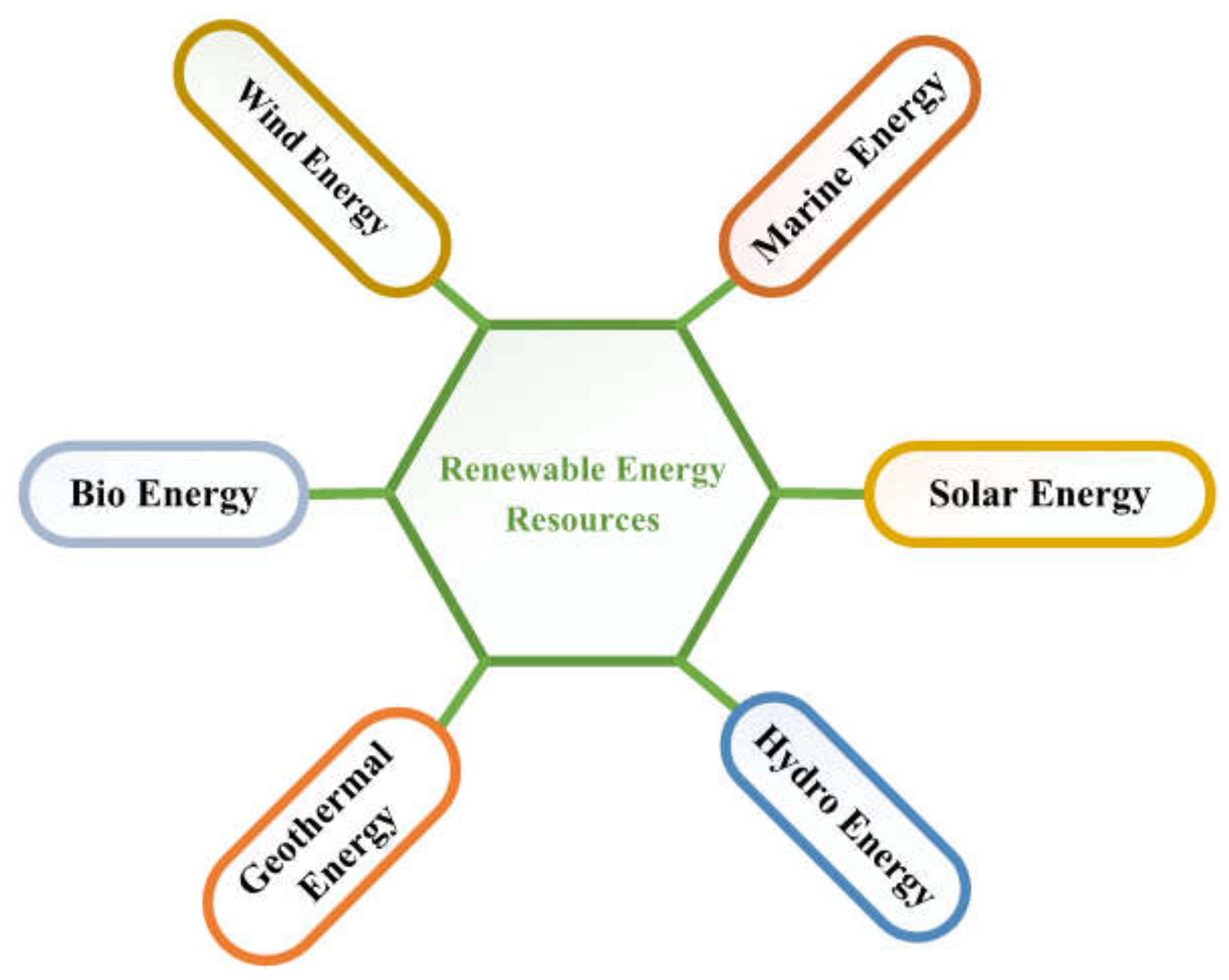

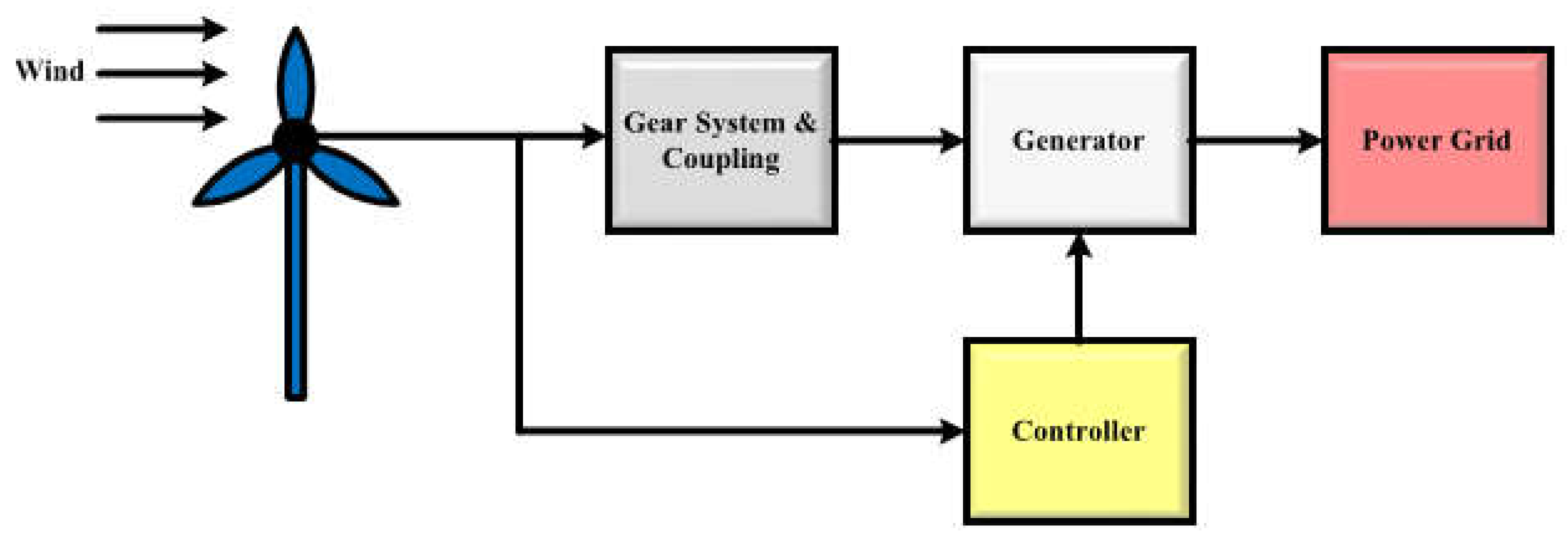
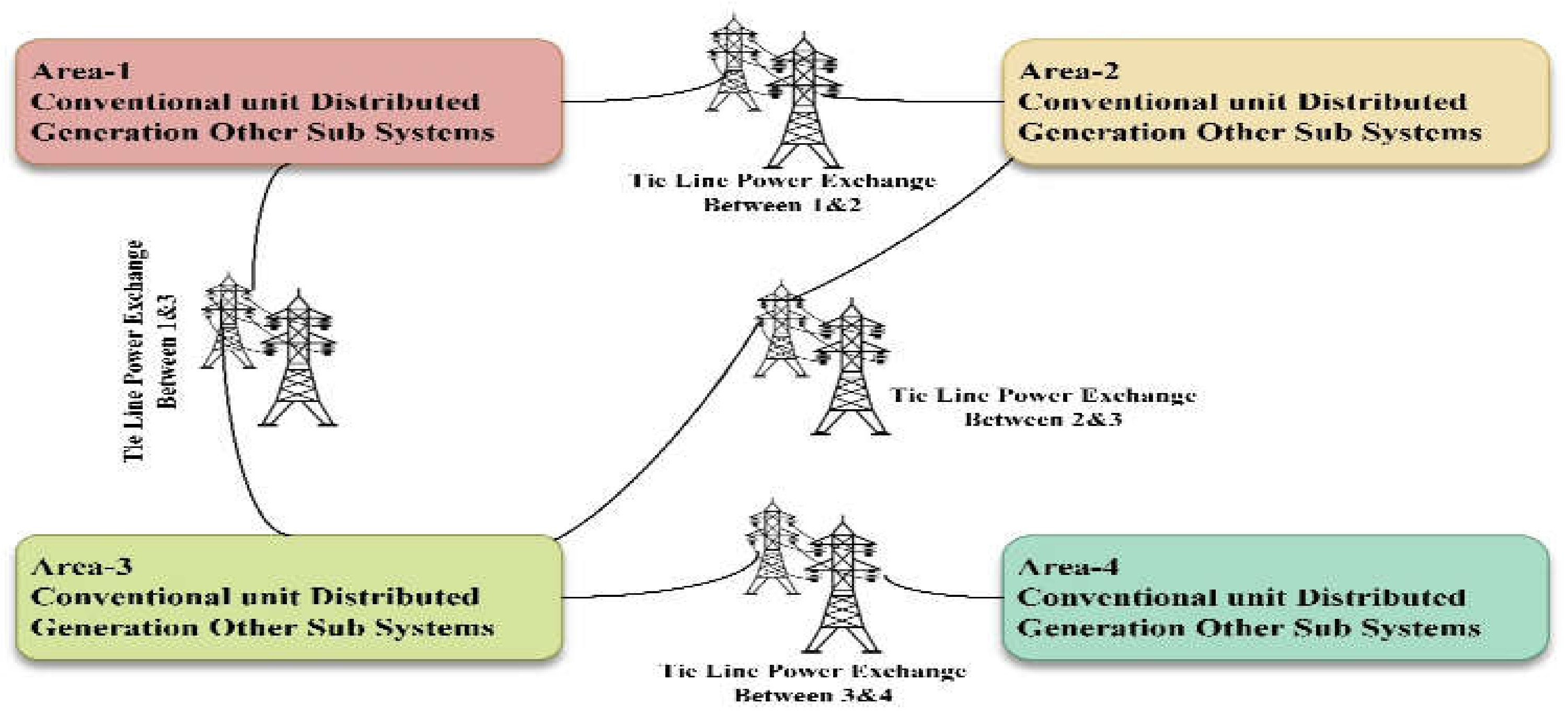

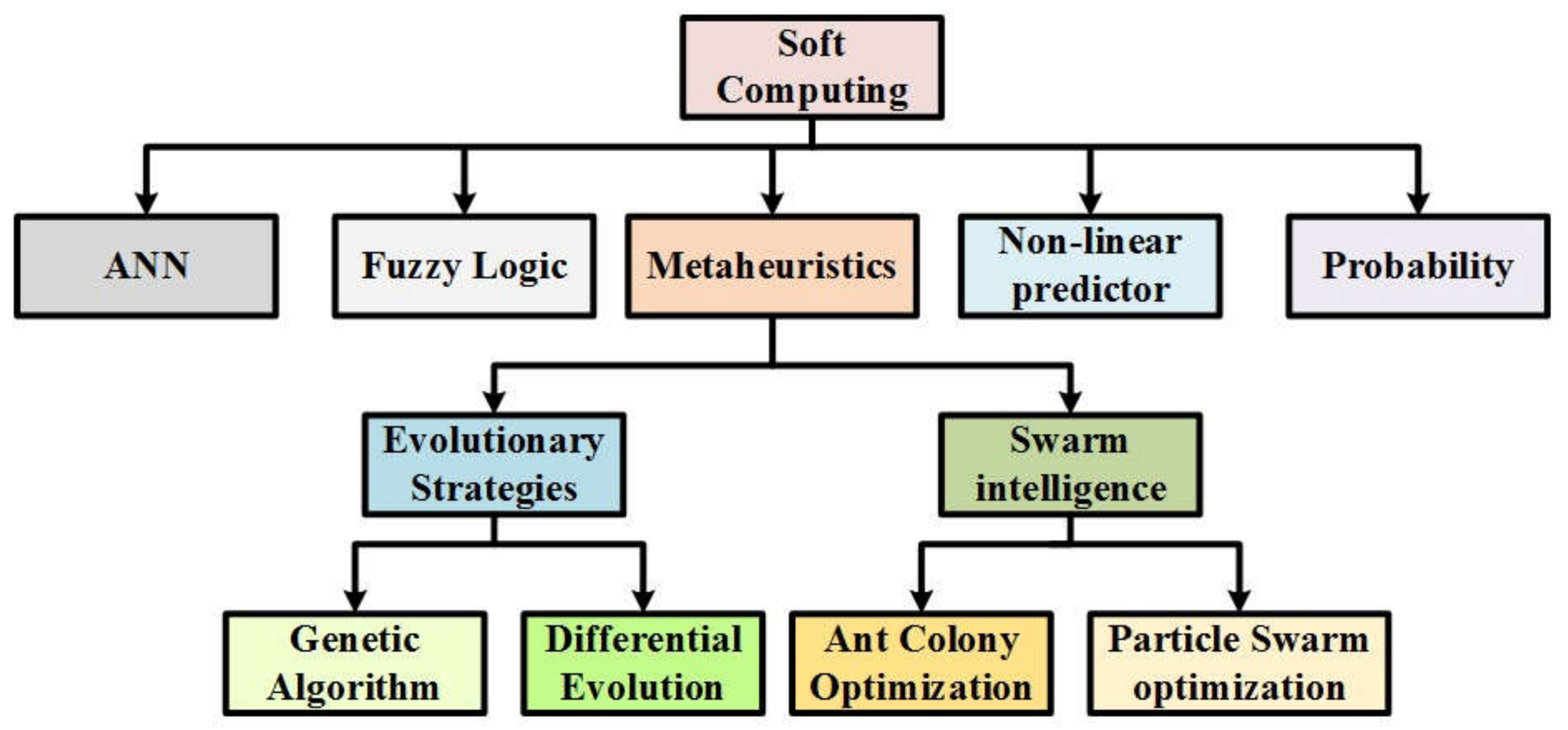
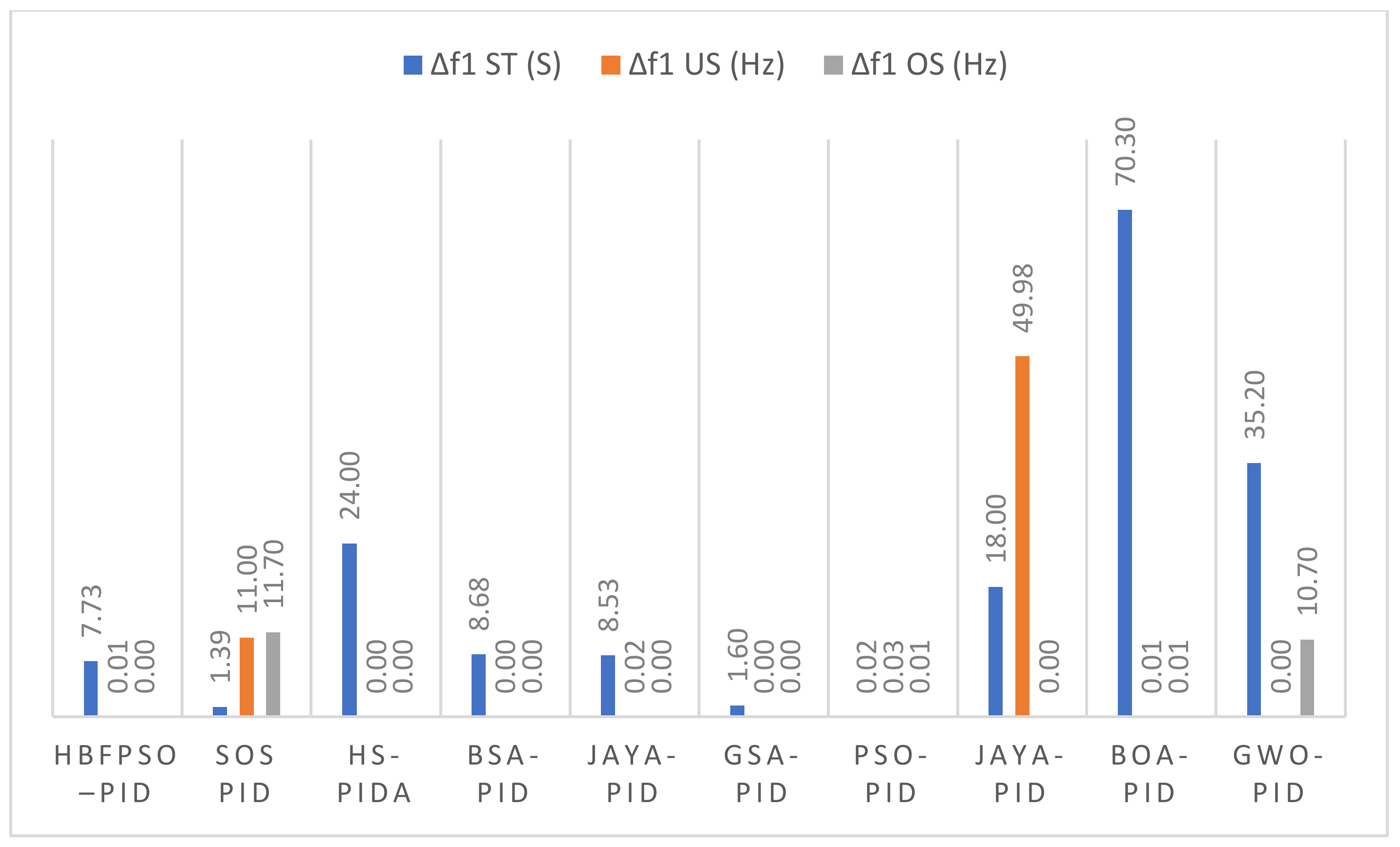
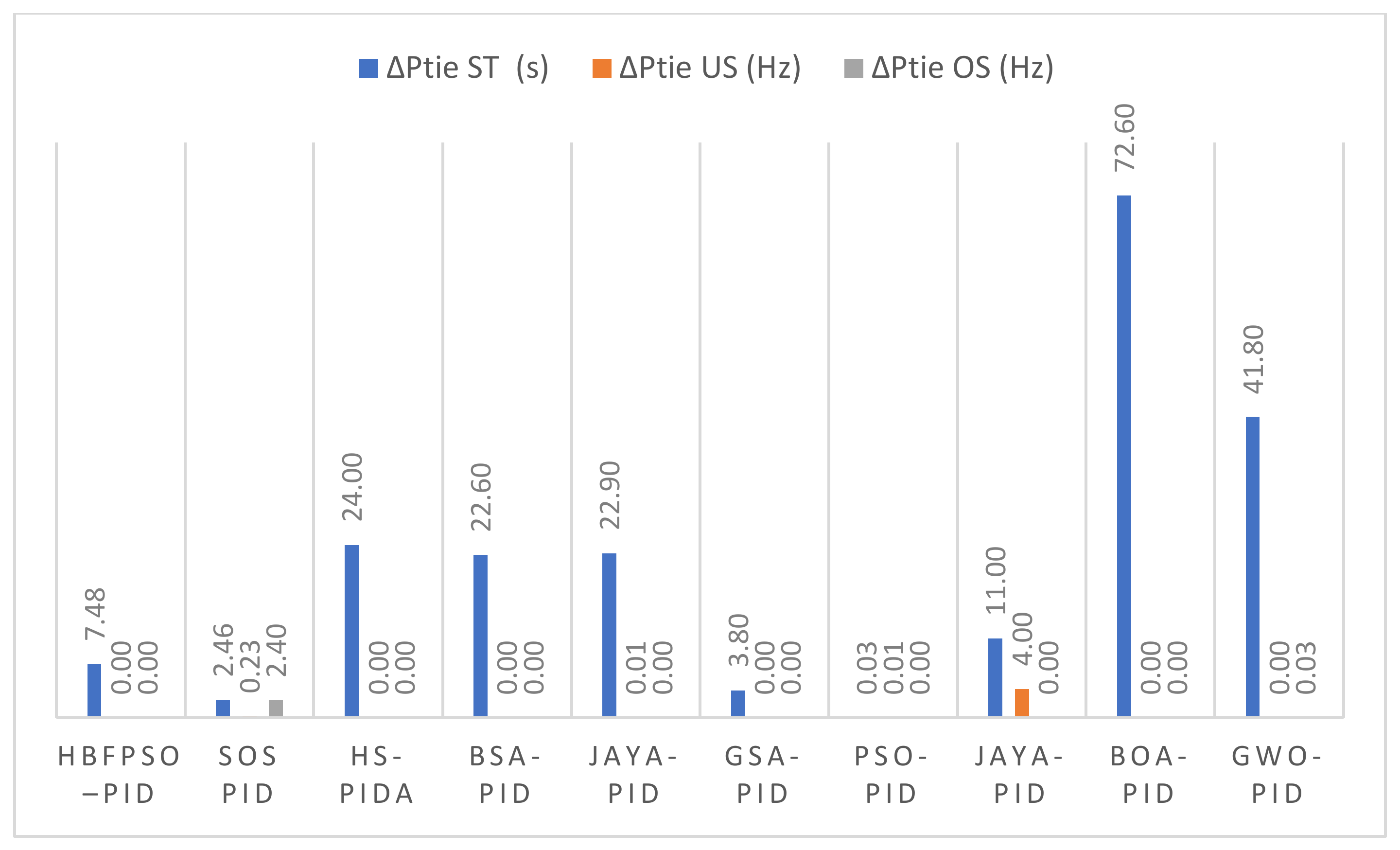
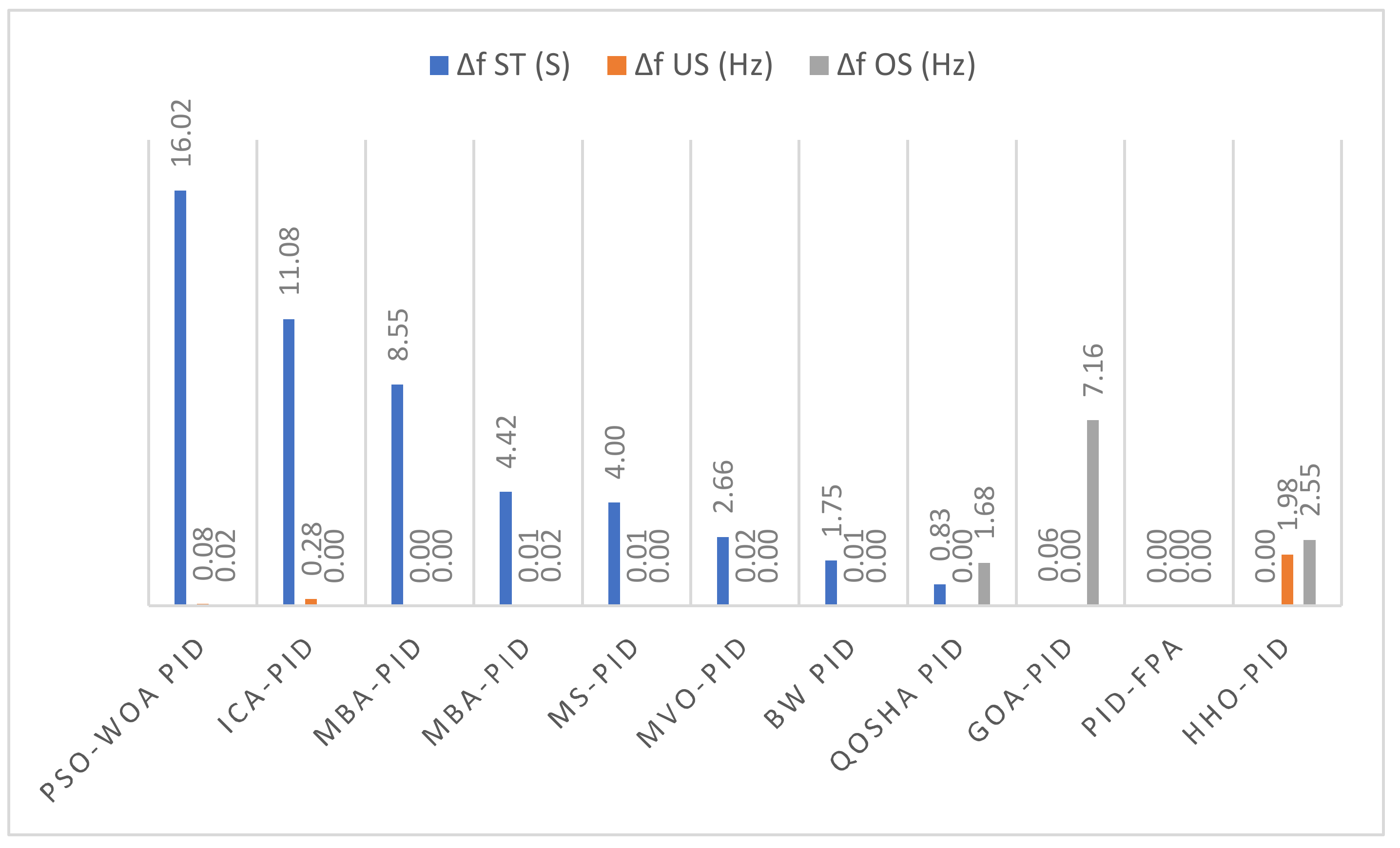
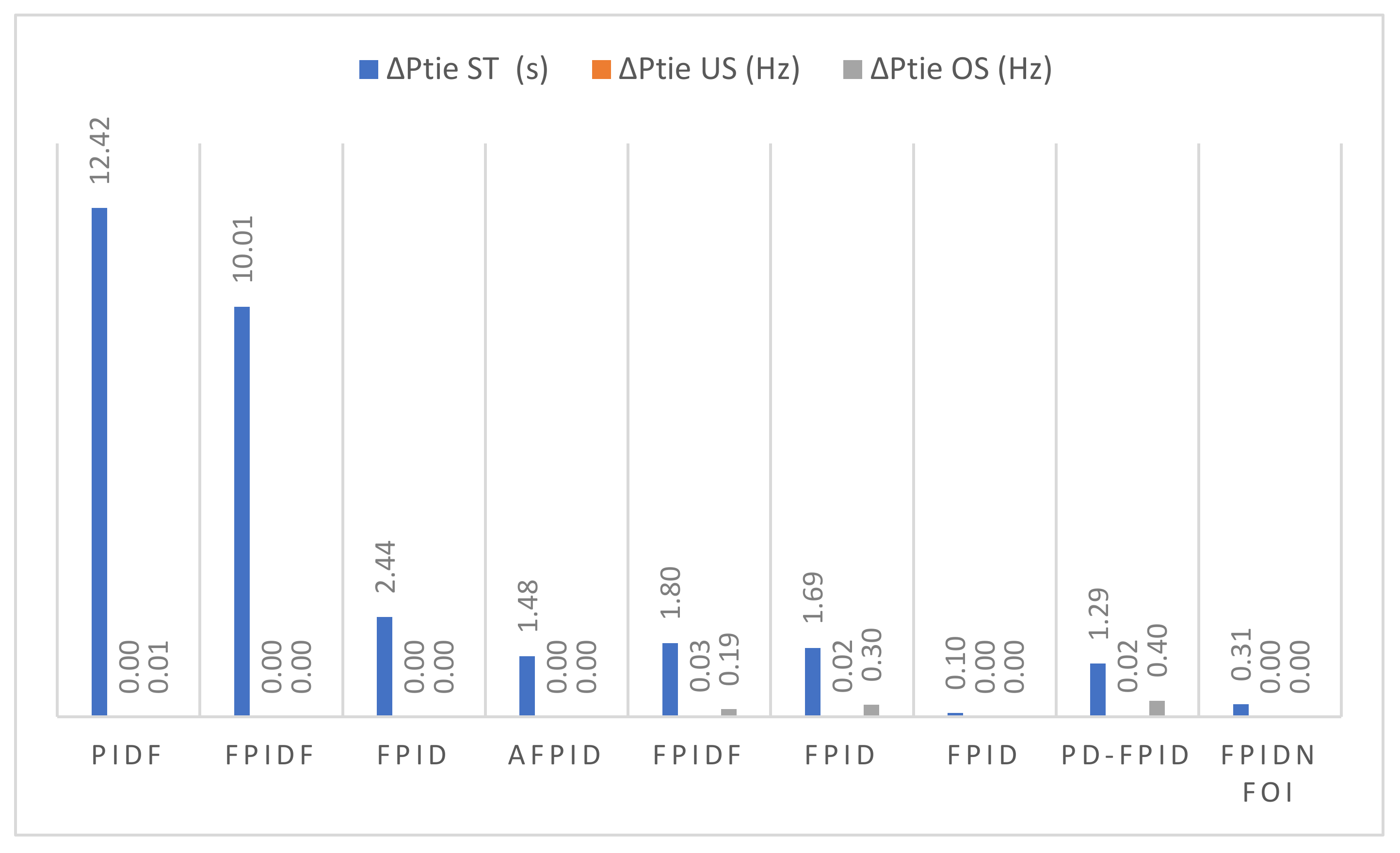
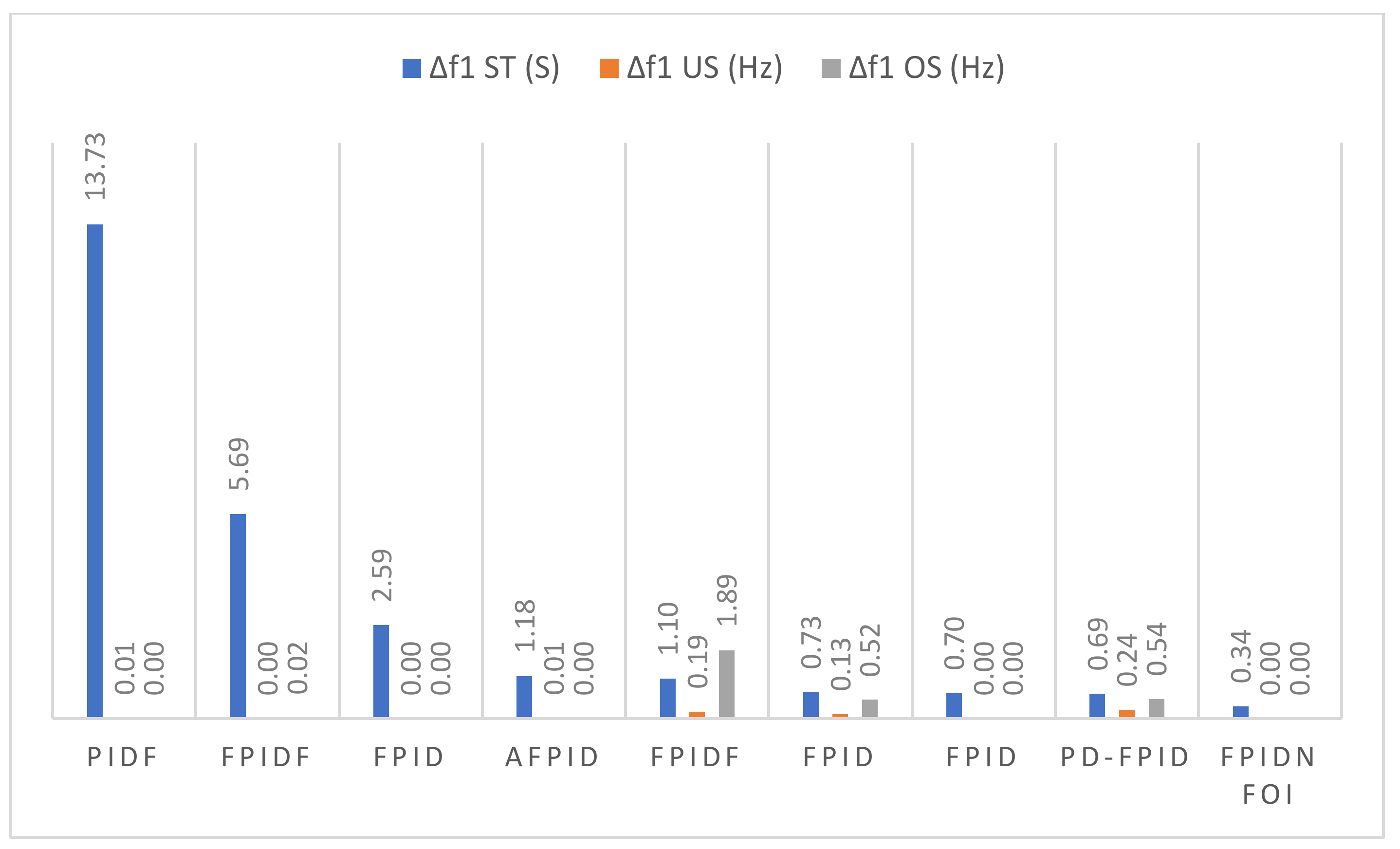
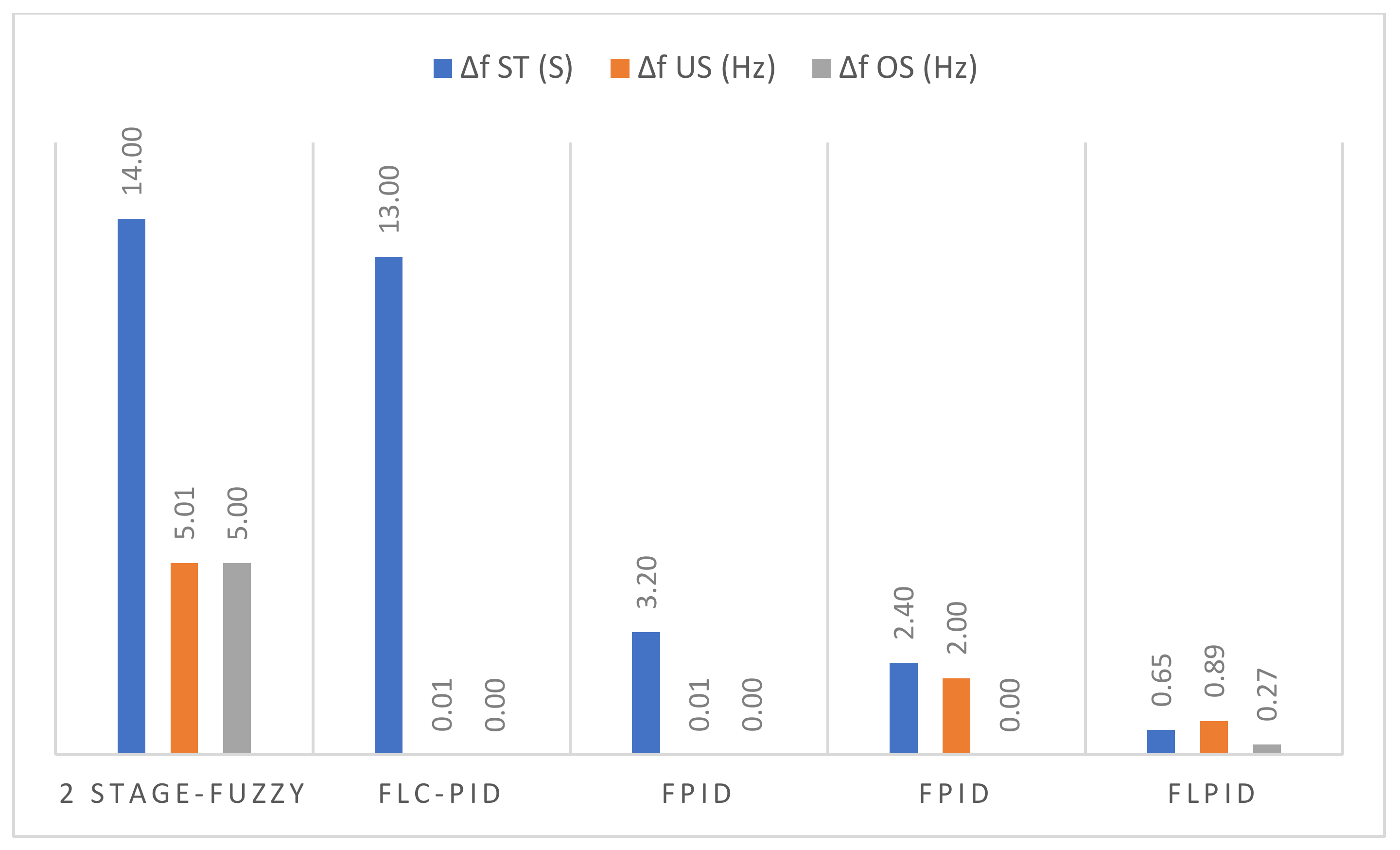
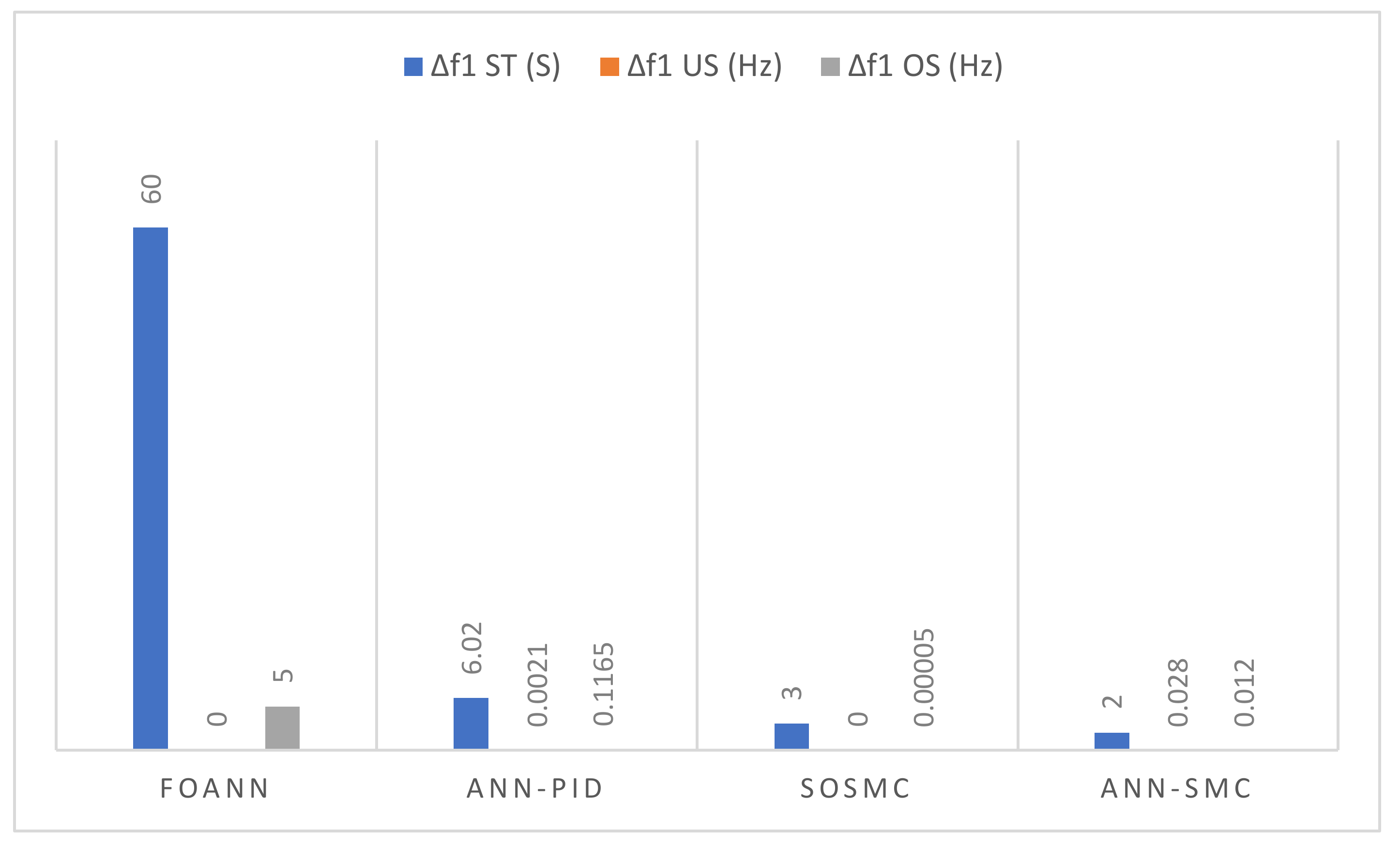
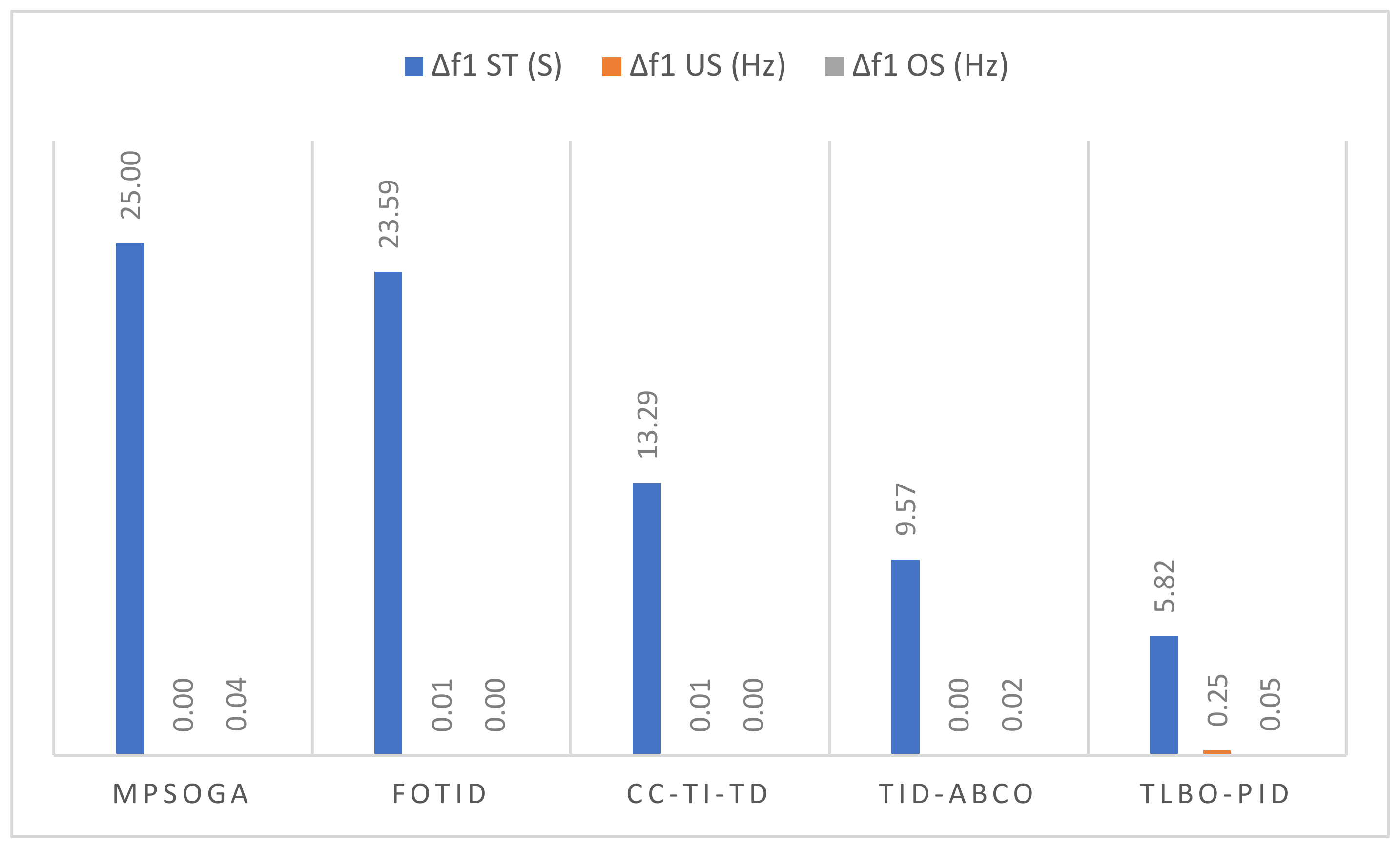
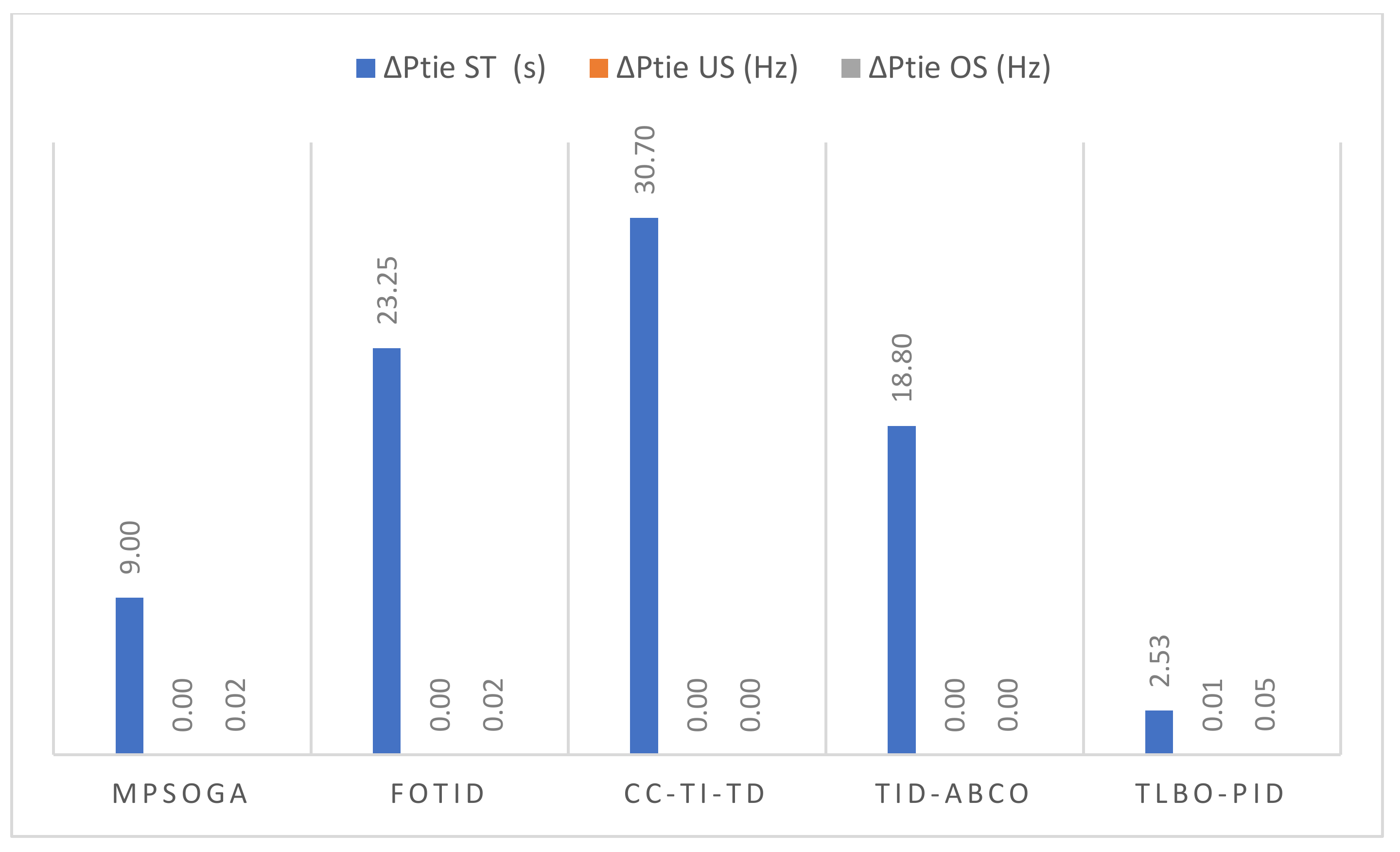
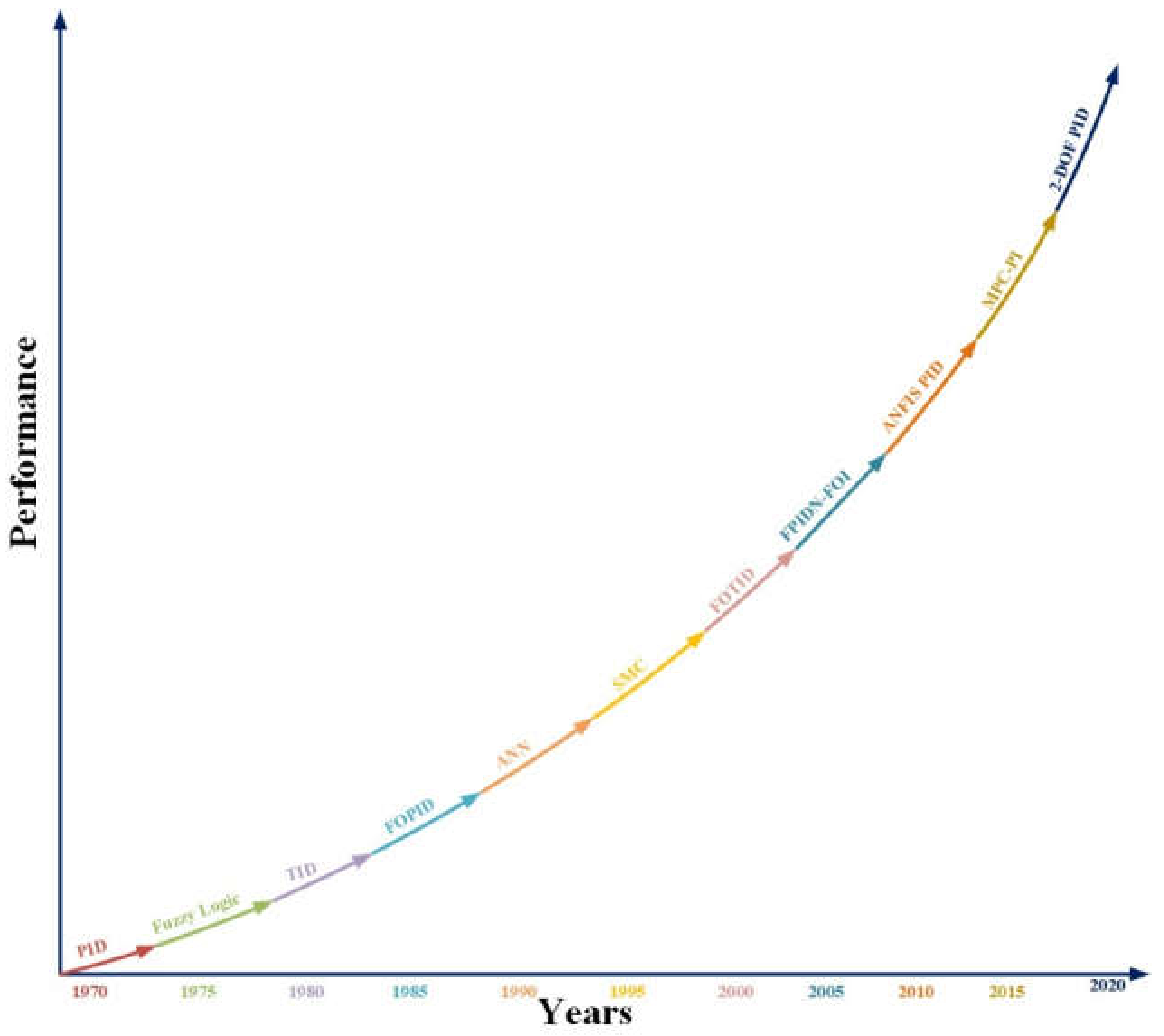
| Performance Indices | [67] HBFPSO-PID | [68] SOS PID | [69] HS-PIDA | [70] BSA-PID | [71] JAYA-PID | [72] GSA-PID | [73] PSO-PID | [74] JAYA-PID | [75] BOA-PID | [76] GWO-PID |
|---|---|---|---|---|---|---|---|---|---|---|
| Δf1 ST (S) | 7.7337 | 1.39 | 24 | 8.68 | 8.53 | 1.6 | 18.23 × 10−3 | 18 | 70.3 | 35.2 |
| Δf1 US (Hz) | 0.0115 | 11 | 0.95 × 10−4 | - | 0.0202 | 0.00269 | 27.48 × 10−3 | 49.98 | 0.0075 | - |
| Δf1 OS (Hz) | - | 11.7 | - | 0.002 | 0.0028 | - | 12.49 × 10−3 | - | 0.0142 | 10.7 |
| Δf2 ST (s) | 7.328 | 2.52 | 12.5 | 25.8 | 7.53 | 3.3 | 16.91 × 10−3 | 15 | 72.02 | 44.2 |
| Δf2 US (Hz) | 0.0086 | 0.655 | −6.3 × 10−4 | - | 0.0159 | 0.0006 | −34.8 × 10−3 | 49.97 | 0.0056 | - |
| Δf2 OS (Hz) | - | 6.8 | 5.00 ×10−5 | 0.0021 | 3.42 ×10−5 | - | 10.45 × 10−3 | - | 0.0121 | 0.011 |
| ΔPtie ST (s) | 7.4793 | 2.46 | 24 | 22.6 | 22.9 | 3.8 | 34.4 × 10−3 | 11 | 72.6 | 41.8 |
| ΔPtie US (Hz) | 0.0024 | 0.228 | 15.8 × 10−4 | - | 0.0125 | 0.00023 | −8.9 × 10−3 | 4 | 0.0023 | - |
| ΔPtie OS (Hz) | - | 2.4 | 15.8 × 10−4 | 1.70 ×10−6 | 0.00167 | - | 0.66 × 10−3 | - | 0.0041 | 0.025 |
| Performance Indices | [77] PSO-WOA PID | [78] ICA-PID | [79] MBA-PID | [80] MBA-PID | [81] MS-PID | [82] MVO-PID | [83] BW PID | [84] QOSHA PID | [85] GOA-PID | [86] PID-FPA | [87] HHO-PID |
|---|---|---|---|---|---|---|---|---|---|---|---|
| Δf ST (S) | 16.02 | 11.08 | 8.5455 | 4.415 | 4 | 2.6605 | 1.75 | 0.832 | 0.057 | 0.00043 | - |
| Δf US (Hz) | 0.082 | 0.28 | 0.00094 | 0.0065 | 0.005 | 0.0216 | 0.01 | - | - | 0.0009 | 1.98 |
| Δf OS (Hz) | 0.024 | - | 0.00451 | 0.0227 | - | - | 0.0025 | 1.676 | 7.16308 | - | 2.551 |
| Performance Indices | [88] PIDF | [89] FPIDF | [90] FPID | [91] AFPID | [92] FPIDF | [93] FPID | [94] FPID | [95] PD-FPID | [96] FPIDN FOI |
|---|---|---|---|---|---|---|---|---|---|
| Δf1 ST (S) | 13.73 | 5.6874 | 2.59 | 1.18 | 1.099 | 0.7294 | 0.7 | 0.6853 | 0.34 |
| Δf1 US (Hz) | 0.0098 | 0 | 5.20 × 10−3 | 9.70 × 10−3 | 0.19 | 0.1296 | 0 | 0.2391 | 0 |
| Δf1 OS (Hz) | 0.0006 | 0.0232 | 5.66 × 10−4 | 0.00 × 100 | 1.89 | 0.52 | 0.0009 | 0.54 | 0.0036 |
| Δf2 ST (s) | 11.96 | 6.4872 | 3.29 | 2.17 × 100 | 2.299 | 1.5128 | 0.2 | 0.9173 | 0.57 |
| Δf2 US (Hz) | 0.0221 | 0 | 5.10 × 10−3 | 2.40 × 10−3 | 0.111 | 0.056 | 0 | 0.0332 | 0 |
| Δf2 OS (Hz) | 0.0032 | 0.0132 | 7.26 × 10−4 | 0.00 × 100 | 0.49 | 1 | 0.00001 | 0.7 | 0.0006 |
| ΔPtie ST (s) | 12.42 | 10.0091 | 2.44 | 1.48 × 100 | 1.798 | 1.6882 | 0.1 | 1.2946 | 0.31 |
| ΔPtie US (Hz) | 0.0005 | 0 | 1.75 × 10−3 | 9.80 × 10−4 | 0.031 | 0.0237 | 0 | 0.0235 | 0 |
| ΔPtie OS (Hz) | 0.0053 | 0.003 | 1.01 × 10−5 | 0.00 × 100 | 0.19 | 0.3 | 0.0001 | 0.4 | 0.00023 |
| Performance Indices | [97] TWO- STAGE FUZZY | [98] FLC-PID | [99] FPID | [100] FPID | [101] FLPID |
|---|---|---|---|---|---|
| Δf ST (S) | 14 | 13 | 3.2 | 2.4 | 0.6537 |
| Δf US (Hz) | 5.009 | 0.009 | 0.0134 | 2 | 0.8924 |
| Δf OS (Hz) | 5.0009 | 0.0005 | 0.0044 | 0 | 0.2723 |
| Performance Indices | [102] FOANN | [103] ANN-PID | [104] SOSMC | [105] ANN-SMC |
|---|---|---|---|---|
| Δf1 ST (S) | 60 | 6.02 | 3 | 2 |
| Δf1 US (Hz) | - | 0.0021 | - | 0.028 |
| Δf1 OS (Hz) | 5 | 0.1165 | 5.00 × 10−5 | 0.012 |
| Δf2 ST (s) | 60 | 6 | 3 | 2.5 |
| Δf2 US (Hz) | - | 0.0015 | - | 0.019 |
| Δf2 OS (Hz) | 5 | 0.141 | 6.50 × 10−3 | 0.008 |
| ΔPtie ST (s) | 20 | 6.42 | - | - |
| ΔPtie US (Hz) | - | 0.0006 | - | - |
| ΔPtie OS (Hz) | 5 | 0.0294 | - | - |
| Performance Indices | [106] MPSOGA | [107] FOTID | [108] CC-TI-TD | [109] TID-ABCO | [110] TLBO-PID |
|---|---|---|---|---|---|
| Δf1 ST (S) | 25 | 23.59 | 13.29 | 9.5654 | 5.82 |
| Δf1 US (Hz) | 0 | 0.0117 | 0.01 | 0 | 0.253 |
| Δf1 OS (Hz) | 0.04 | 0.0026 | 0.00 | 0.0241 | 0.045 |
| Δf2 ST (s) | 0 | 18.77 | 32.10 | 11.104 | 0.2312 |
| Δf2 US (Hz) | 16 | 0.0068 | 0.00 | 0 | 0.0336 |
| Δf2 OS (Hz) | 0.03 | 0.0228 | 0.00 | 0.0291 | 0 |
| ΔPtie ST (s) | 9 | 23.25 | 30.70 | 18.7992 | 2.53 |
| ΔPtie US (Hz) | 0 | 0.0044 | 0.00 | 0 | 0.0064 |
| ΔPtie OS (Hz) | 0.023 | 0.0245 | 0.00 | 0.0048 | 0.05 |
Publisher’s Note: MDPI stays neutral with regard to jurisdictional claims in published maps and institutional affiliations. |
© 2022 by the authors. Licensee MDPI, Basel, Switzerland. This article is an open access article distributed under the terms and conditions of the Creative Commons Attribution (CC BY) license (https://creativecommons.org/licenses/by/4.0/).
Share and Cite
Gulzar, M.M.; Iqbal, M.; Shahzad, S.; Muqeet, H.A.; Shahzad, M.; Hussain, M.M. Load Frequency Control (LFC) Strategies in Renewable Energy-Based Hybrid Power Systems: A Review. Energies 2022, 15, 3488. https://doi.org/10.3390/en15103488
Gulzar MM, Iqbal M, Shahzad S, Muqeet HA, Shahzad M, Hussain MM. Load Frequency Control (LFC) Strategies in Renewable Energy-Based Hybrid Power Systems: A Review. Energies. 2022; 15(10):3488. https://doi.org/10.3390/en15103488
Chicago/Turabian StyleGulzar, Muhammad Majid, Muhammad Iqbal, Sulman Shahzad, Hafiz Abdul Muqeet, Muhammad Shahzad, and Muhammad Majid Hussain. 2022. "Load Frequency Control (LFC) Strategies in Renewable Energy-Based Hybrid Power Systems: A Review" Energies 15, no. 10: 3488. https://doi.org/10.3390/en15103488
APA StyleGulzar, M. M., Iqbal, M., Shahzad, S., Muqeet, H. A., Shahzad, M., & Hussain, M. M. (2022). Load Frequency Control (LFC) Strategies in Renewable Energy-Based Hybrid Power Systems: A Review. Energies, 15(10), 3488. https://doi.org/10.3390/en15103488










